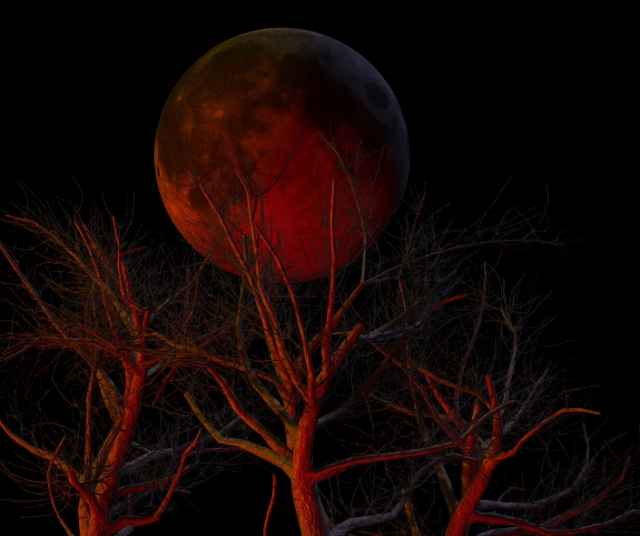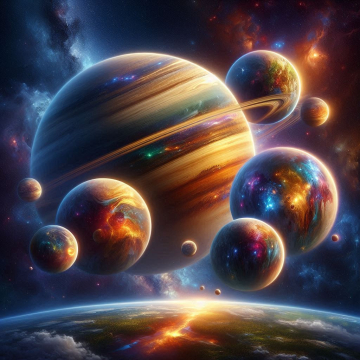The Moon, our faithful satellite, has captivated humanity since time immemorial. Among its numerous phases and astronomical events, the Blood Moon stands out as one of the most intriguing and mysterious phenomena. In this article, we will delve into the fascinating world of the Blood Moon, exploring its scientific causes, its cultural significance, and its impact on the human imagination throughout history.
Blood Moon: A Cosmic Ballet of Lunar Eclipses.
The Blood Moon, also known as a total lunar eclipse, is an astronomical phenomenon that occurs when the Earth comes between the Sun and the Moon, casting its shadow on our natural satellite. During a total lunar eclipse, the Moon takes on a reddish hue, which has led to the popularization of the term "Blood Moon." This cosmic spectacle is the result of the refraction of sunlight as it passes through the Earth's atmosphere, scattering the shorter wavelengths and allowing only the red ones to reach the Moon.
Total lunar eclipses are not everyday events; Its frequency varies and depends on several astronomical factors. When they occur, they offer observers on Earth the opportunity to witness an impressive cosmic ballet, where the Moon goes from a silvery glow to a copper hue, plunging into the Earth's shadow.
The Science Behind the Show: The Cosmic Dance of the Earth, Moon and Sun.
To understand the Blood Moon, it is essential to dive into the precise mechanics behind this phenomenon. A total lunar eclipse occurs when the Moon, Earth, and Sun are aligned in a linear formation, with the Earth located between the Moon and the Sun. When the Moon enters the shadow cast by the Earth, direct sunlight is blocked. , and the Moon acquires that characteristic reddish tone.
The Earth's atmosphere plays a crucial role in this process. As sunlight passes through the atmosphere, shorter wavelengths (such as blue and green) are scattered, allowing longer wavelengths (such as red) to pass through. This creates the visual effect that transforms the Moon into a reddish sphere during the total lunar eclipse.
The Show of the Century: Longest Lunar Eclipses.
Throughout history, the Blood Moon has been the subject of wonder and speculation. Some total lunar eclipses have been noted for their exceptional duration and visual impact. In the 21st century, on July 27, 2018, a total lunar eclipse occurred that captured the attention of people around the world. This event, considered the longest lunar eclipse of the century, lasted approximately 1 hour and 43 minutes.
During this eclipse, the Moon took on a deep reddish hue, providing observers with a unique celestial experience. The longevity of the event allowed audiences in different parts of the world to enjoy an extended view of the Blood Moon, generating excitement and contributing to growing public awareness of astronomical events.
The Blood Moon in Mythology and Popular Culture.
The Moon, throughout history, has played a prominent role in myths and legends. The Blood Moon, with its unusual appearance and reddish hue, has inspired numerous interpretations in various cultures around the world.
In some traditions, Blood Moons are associated with omens or significant events. In others, they are considered mystical moments that connect heaven and earth. The diversity of interpretations reflects the cultural richness of humanity and the way the Moon has influenced our understanding of the cosmos and our spiritual narratives.
Cultural Significance: The Blood Moon in Beliefs and Rituals.
The Blood Moon has been the focus of numerous rituals and celebrations throughout history. In some cultures, it is considered an auspicious time for meditation and introspection. In others, magical and healing powers are attributed to it.
For indigenous and ancestral communities, the Blood Moon can have specific connotations depending on their mythologies and beliefs. Observing these astronomical events is often accompanied by ceremonies and cultural practices that honor the connection between the cosmos and life on Earth.
The Influence on Art and Literature: Blood Moon in the Human Imagination.
The Blood Moon has inspired artists and writers throughout time, giving rise to works of art, poetry and narrative that capture its mysterious splendor. Painters such as Edvard Munch have captured the intense and evocative atmosphere of the Blood Moon in their creations, while poets have woven verses full of symbolism and emotion.
In contemporary literature, the Blood Moon continues to be a recurring theme in genres such as science fiction and fantasy, where magical and transcendental meanings are attributed to it. Its presence in the human imagination highlights the deep emotional connection we maintain with celestial phenomena.
Effects in Astrology: The Blood Moon in the Zodiac.
Astrology, an ancient practice that relates the position of celestial bodies to events on Earth, also finds meaning in the Blood Moon. In astrology, the Moon is associated with emotions and the unconscious, and a total lunar eclipse is often interpreted as a time of transformation and change.
Different astrological traditions attribute specific meanings to the Blood Moon depending on its position in the zodiac and its aspects with other planets. Astrologers often offer personalized readings during these events, seeking to guide people through periods of transition and personal growth.
The Blood Moon, a Celestial Testimony of Beauty and Mystery.
The Blood Moon, with its reddish hue and its astronomical origin, stands out as a celestial testimony of the beauty and mystery that our universe contains. From the science that explains its colors to the cultural interpretations that surround it, the Blood Moon continues to be a phenomenon that awakens wonder and reflection in humanity.
Beyond its role in astrophysics, the Blood Moon has left an indelible mark on human culture, inspiring myths, rituals, and works of art that celebrate its presence in the sky. In each event, the Blood Moon reminds us of our connection to the cosmos and invites us to contemplate the vast and mysterious universe we share with our faithful nocturnal companion. So, as we continue to explore the heavens, the Blood Moon remains as a beacon illuminating the infinite wonder of space around us.






